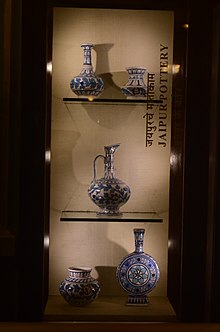
Blue pottery is widely recognized as a traditional craft of Jaipur of Central Asian origin.[1] The name 'blue pottery' comes from the eye-catching cobalt blue dye used to colour the pottery. It is one of many Eurasian types of blue and white pottery, and related in the shapes and decoration to Islamic pottery and, more distantly, Chinese pottery.
Jaipur blue pottery has been strongly influenced by the Persian ceramic style but it has developed its own designs and motifs. Inspired more from nature, the pottery is adorned profusely with animals, birds and flowers with a hint of Persian geometric design in the compositions.[2] Some of this pottery is semi-transparent and mostly decorated with Mughal arabesque patterns and bird and other animal motifs, a design forbidden in Persian art of Islamic origin.
Jaipur blue pottery, made out of ceramic frit material similar to Egyptian faience, is glazed and low-fired. No clay is used: the 'dough' for the pottery is prepared by mixing quartz stone powder, powdered glass, multani mitti (fuller's earth), borax, gum and water.[1] Another source cites Katira Gond powder (a gum), and saaji (soda bicarbonate) as ingredients.[3] Like pottery it is fired only once. The biggest advantage is that blue pottery does not develop any cracks, and blue pottery is also impervious, hygienic, and suitable for daily use. Blue pottery is beautifully decorated with the brush when the pot is rotated.[4] Thus it has great utilitarian as well as aesthetic significance.
Being fired at very low temperature makes them fragile. The range of items is primarily decorative, such as ashtrays, vases, coasters, small bowls and boxes for trinkets. The colour palette is restricted to blue derived from the cobalt oxide, green from the copper oxide and white, though other non-conventional colours, such as yellow and brown are sometimes included.[5] The products made include plates, flower vases, soap dishes, surahis (small pitcher), trays, coasters, fruit bowls, door knobs, and glazed tiles with hand painted floral designs. Sometimes, designer pieces for display are also made. The craft is found mainly in Jaipur, but also in Sanganer, Mahalan, and Neota.[6]


- ^ a b Subodh Kapoor (2002). "Blue Pottery of Jaipur". The Indian Encyclopaedia. Cosmo Publications. p. 935. ISBN 978-81-7755-257-7. Retrieved 23 April 2012.
- ^ Taknet, DK (July 2016). Jaipur: Gem of India. IntegralDMS. ISBN 9781942322054.
- ^ "Craftmark Certified Processes: Blue Pottery". All India Artisans and Craftworkers Welfare Association. Archived from the original on 23 July 2015.
- ^ "Blue Pottery - Rajasthan Industries". Retrieved 23 November 2022.
- ^ Museum, Alankar (2011). Tryst with Tradition: Exploring Rajasthan Through the Alankar Museum, Jawahar Kala Kendra. Jawahar Kala Kendra.
- ^ "Blue Pottery - Rajasthan Industires". Retrieved 23 November 2022.